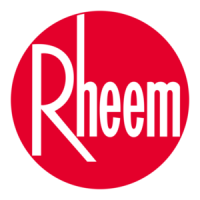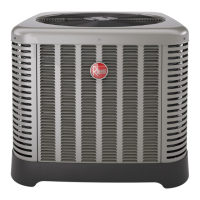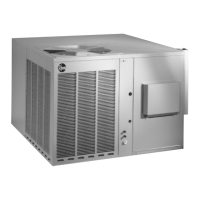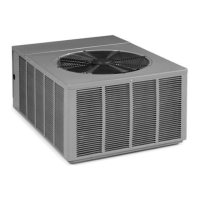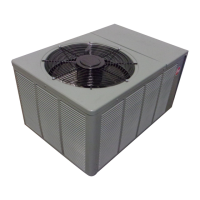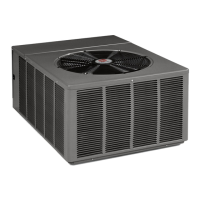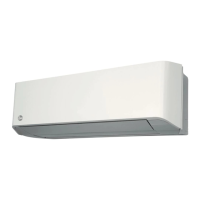7
4.0 INSTALLATION
Tools
4.1 Tools and Refrigerant
4.1.1 Tools Required for Installing
and Servicing R-410A Models
Manifold Sets:
– Up to 800 PSIG [5,516 kPa] High-Side
– Up to 250 PSIG [1,724 kPa] Low-Side
– 550 PSIG [3,792 kPa] Low-Side Retard
Manifold Hoses:
– Service Pressure Rating of 800 PSIG [5,516 kPa]
Recovery Cylinders:
– 400 PSIG [2,758 kPa] Pressure Rating
– Dept. of Transportation 4BA400 or BW400
Item Number Descripton
1 Ambient and Tube Thermometers
2 Crescent Wrench
3 Allen Wrench
4 Manifold Gauge Set
5 Brazing Rods
6 Recovery Cylinders
7 Nitrogen
8 Torch
9 Reclaimer
Figure 2: Required Tools for Unit Installation
CAUTION:
R-410A systems operate at higher pressures than
R-22 systems. Do not use R-22 service equipment or
components on R-410A equipment.
4.1.2 Specications of R-410A
Application: R-410A is not a drop-in replacement
for R-22. Equipment designs must accommodate its
higher pressures. It cannot be retrofitted into R-22 heat
pumps.
Physical Properties: R-410A has an atmospheric
boiling point of -62.9°F [-52.7°C] and its saturation
pressure at 77°F [25°C] is 224.5 psig [1,548 kPa].
Composition: R-410A is a near-azeotropic mixture of
50% by weight difluoromethane (HFC-32) and 50% by
weight pentafluoroethane (HFC-125).
Pressure: The pressure of R-410A is approximately
60% (1.6 times) greater than R-22. Recovery and
recycle equipment, pumps, hoses, and the like must
have design pressure ratings appropriate for R-410A.
Manifold sets need to range up to 800 psig [5,516
kPa] high-side and 250 psig [1,724 kPa] low-side with
a 550 psig [3,792 kPa] low-side retard. Hoses need to
have a service pressure rating of 800 psig [5,516 kPa].
Recovery cylinders need to have a 400 psig [2,758
kPa] service pressure rating, DOT 4BA400 or DOT
BW400.
Combustibility: At pressures above 1 atmosphere, a
mixture of R-410A and air can become combustible.
R-410A and air should never be mixed in tanks
or supply lines or be allowed to accumulate in
storage tanks. Leak checking should never be
done with a mixture of R-410A and air. Leak-
checking can be performed safely with nitrogen or a
mixture of R-410A and nitrogen.
4.1.3 Quick-Reference Guide for
R-410A
• R-410A refrigerant operates at approximately 60%
higher pressure (1.6 times) than R-22. Ensure that
servicing equipment is designed to operate with
R- 410A .
• R-410A refrigerant cylinders are light rose in color.
• R-410A, as with other HFCs, is only compatible
with POE oils.
• Vacuum pumps will not remove moisture from POE
oil used in R-410A systems.
• R-410A systems are to be charged with liquid
refrigerants. Prior to March 1999, R-410A
refrigerant cylinders had a dip tube. These
cylinders should be kept upright for equipment
charging. Post-March 1999 cylinders do not have
a dip tube and should be inverted to ensure liquid
charging of the equipment.
• Do not install a suction line filter drier in the liquid
line.
• A factory-approved bi-flow liquid line filter drier
is shipped with every unit and must be installed
in the liquid line at the time of installation. Only
manufacturer-approved liquid line filter driers
should be used. Filter driers must have a working
pressure rating of at least 600 psig [4,137 kPa].
The filter drier will only have adequate moisture-
holding capacity if the system is properly
evacuated.
• Desiccant (drying agent) must be compatible for
POE oils and R-410A refrigerant.
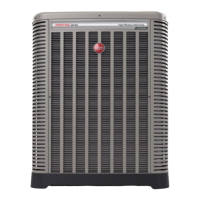
